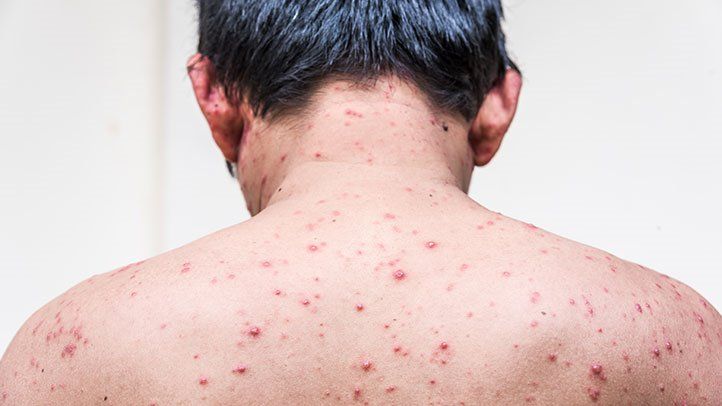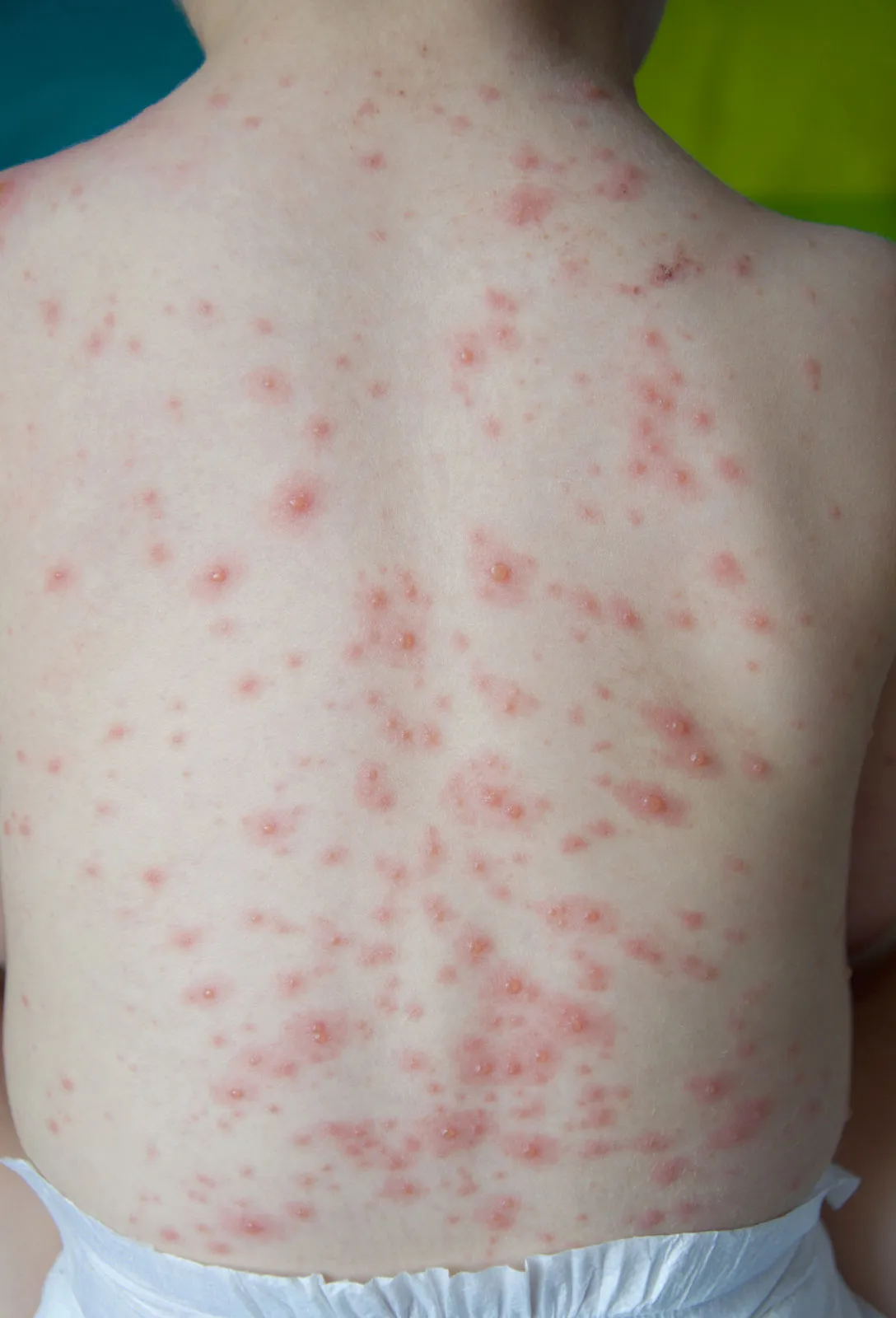Chickenpox, caused by the varicella-zoster virus, results in an itchy rash with small, fluid-filled blisters. It spreads easily to those who haven’t had the disease or the vaccine. While it was once widespread, the chickenpox vaccine now effectively protects children from the illness and its associated health complications. The vaccine is a safe and effective preventive measure.
Chickenpox Causes
Chickenpox is caused by the varicella-zoster virus and spreads easily and quickly from an infected person.
Who Gets Chickenpox?
Children under the age of 2 are most at risk, with 90% of all cases occurring in young children. However, older children and adults can also contract chickenpox.
How Do You Get Chickenpox?
You can get chickenpox by touching the rash or fluid from the blisters of someone who has the virus. It can also spread through respiratory droplets if an infected person coughs or sneezes near you. Those with chickenpox are contagious from 1 to 2 days before the rash appears until all blisters have dried and crusted over.
Chickenpox Incubation Period
Symptoms typically appear within 10 to 21 days after exposure to the virus.
Chickenpox Symptoms
The initial symptom of chickenpox is usually a general feeling of unwellness.
Other Symptoms of Chickenpox
The rash caused by chickenpox appears 10 to 21 days after exposure to the varicella-zoster virus and typically lasts about 5 to 10 days. Other symptoms that may appear 1 to 2 days before the rash include:
- Fever
- Loss of appetite
- Headache
- Tiredness and general malaise
Phases of the Chickenpox Rash
Once the rash appears, it progresses through three phases:
- Papules: Raised bumps that break out over a few days.
- Vesicles: Small fluid-filled blisters that form within about one day, then break and leak.
- Crusts and Scabs: These cover the broken blisters and take a few more days to heal.
New bumps keep appearing for several days, so you may have bumps, blisters, and scabs simultaneously. The virus can spread to others up to 48 hours before the rash appears and remains contagious until all blisters have crusted over.
Severity and Complications
While chickenpox is generally mild in healthy children, the rash can sometimes cover the entire body. Blisters may form in the throat, eyes, and mucous membranes lining the urethra, anus, and vagina.
When to See a Doctor
If you suspect you or your child has chickenpox, contact your healthcare provider. Chickenpox can often be diagnosed through an examination of the rash and other symptoms. Medication may be necessary to combat the virus or treat complications. To prevent spreading the virus in the waiting room, call ahead and inform the office that you suspect chickenpox.
Contact your provider if:
- The rash spreads to one or both eyes.
- The rash becomes very warm or tender, which could indicate a bacterial infection.
- More severe symptoms accompany the rash, such as dizziness, confusion, fast heartbeat, shortness of breath, shakiness, muscle coordination issues, worsening cough, vomiting, stiff neck, or a fever above 102 F (38.9 C).
- You live with people who have never had chickenpox and haven’t been vaccinated.
- Someone in your household is pregnant.
- Someone in your household has a disease or takes medication that affects the immune system.
Risk Factors
Your risk of contracting the varicella-zoster virus, which causes chickenpox, is higher if you haven’t had chickenpox or the chickenpox vaccine. This is especially important for those working in childcare or school settings to be vaccinated.
Most people who have had chickenpox or the vaccine are immune. If vaccinated individuals do contract chickenpox, the symptoms are typically milder, with fewer blisters and little to no fever. It’s rare but possible to get chickenpox more than once.

Complications
While chickenpox is generally mild, it can lead to serious health problems, including:
- Bacterial infections of the skin, soft tissues, bones, joints, or bloodstream.
- Dehydration due to insufficient fluids.
- Pneumonia.
- Encephalitis (brain swelling).
- Toxic shock syndrome.
- Reye’s syndrome (swelling in the brain and liver) in children and teens who take aspirin during chickenpox.
- In rare cases, chickenpox can be fatal.
Who’s at Risk?
People at higher risk for chickenpox complications include:
- Newborns and infants whose mothers haven’t had chickenpox or the vaccine.
- Children under 1 year who haven’t been vaccinated.
- Teens and adults.
- Pregnant women who haven’t had chickenpox.
- Smokers.
- Individuals with cancer or HIV, or those on immunosuppressive medications.
- People with chronic conditions like asthma who take immune-suppressing drugs, or those who’ve had organ transplants.
Chickenpox and Pregnancy
Babies born to mothers infected with chickenpox early in pregnancy may have low birth weight and limb problems. If a pregnant woman contracts chickenpox just before or after giving birth, the baby is at higher risk for a life-threatening infection. Pregnant women not immune to chickenpox should discuss risks with their healthcare provider.
Chickenpox and Shingles
If you’ve had chickenpox, you’re at risk for shingles later in life. The varicella-zoster virus remains dormant in nerve cells and can reactivate as shingles, causing painful blisters. Shingles risk increases with age and weakened immune systems. The pain, known as postherpetic neuralgia, can persist after blisters heal.
The CDC recommends the Shingrix vaccine for those 50 and older and for individuals 19 and older with weakened immune systems. Shingrix is advised even if you’ve had shingles or the older Zostavax vaccine. Other shingles vaccines are available outside the U.S.; consult your provider for more information.

Chickenpox Treatment
Medications
- Acetaminophen (Tylenol):
- Use acetaminophen to reduce fever and relieve pain from sores on the skin or in the mouth. It’s safe for most people, including pregnant women. For children over 2 months old, use a child-specific product and follow dosing instructions.
- Note: Avoid anti-inflammatory painkillers like ibuprofen in children with chickenpox, as they can lead to serious bacterial skin infections. Never give aspirin to children under 16 due to the risk of Reye’s syndrome, which can affect the liver and brain and be fatal.
- Prescription Medicine:
- If exposed to chickenpox but not yet symptomatic, your doctor might administer immune globulin to help your immune system fight the virus. This may be considered for:
- Children and adults with weakened immune systems
- Newborns of mothers with chickenpox shortly before or after delivery
- Premature babies
- Babies under 1 year old
- Adults without evidence of immunity
- Pregnant women
- Smokers
- People with HIV
- Those undergoing chemotherapy or on high doses of steroids
- For those at risk of severe chickenpox and already symptomatic, an antiviral medication called acyclovir (Sitavig, Zovirax) may be prescribed. It’s most effective if started within 24 hours of rash onset.
Don’t Scratch
- Scratching can lead to bacterial skin infections and scarring. If you scratch, wash your hands with soap and water to avoid spreading the virus.
Can You Get Chickenpox Twice?
- While rare, it is possible to get chickenpox more than once.
Chickenpox Home Remedies
To Ease Symptoms:
- Take a lukewarm bath with colloidal oatmeal or baking soda.
- Apply calamine lotion to itchy spots.
- Take oral antihistamines to reduce itching.
- Get plenty of rest.
Additional Tips:
- Keep Cool: Heat and sweat can worsen itching. Use a cool, wet washcloth on itchy areas to soothe your skin.
- Stay Hydrated: Drink plenty of fluids to help your body clear the virus faster and prevent dehydration.
General Care Tips:
Keep Skin Clean:
- Bathe regularly with lukewarm water.
- Use mild, fragrance-free soap to avoid irritating the skin.
Prevent Scratching:
- Keep nails trimmed short to minimize damage from scratching.
- Wear mittens or gloves, especially at night, to prevent scratching during sleep.
- Apply anti-itch treatments like calamine lotion or colloidal oatmeal baths to reduce discomfort.
Soothe Itchy Skin:
- Colloidal Oatmeal Baths: Add colloidal oatmeal to a lukewarm bath to soothe itchy skin.
- Calamine Lotion: Dab calamine lotion on itchy spots to relieve itching.
- Cool Compresses: Apply cool, damp washcloths to itchy areas to calm the skin.
Avoid Irritants:
- Wear loose, soft clothing to prevent irritation.
- Avoid using hot water, which can make itching worse.
- Steer clear of lotions or soaps with strong fragrances or alcohol.
Maintain Hydration: Drink plenty of fluids to keep the body hydrated, which helps in faster recovery.
Avoid Overheating:
- Stay in a cool environment to prevent sweating, which can exacerbate itching.
- Use fans or air conditioning to maintain a comfortable temperature.
Specific Remedies and Treatments:
Oral Antihistamines:
- Take oral antihistamines, like diphenhydramine (Benadryl), to help manage itching. Follow the dosage instructions provided by your healthcare provider.
Topical Treatments:
- Hydrocortisone Cream: Apply a mild hydrocortisone cream to reduce inflammation and itching. Use it sparingly and only on the affected areas.
- Antiviral Creams: If prescribed by a doctor, use antiviral creams to help reduce the severity of the rash.
Manage Blisters:
- Keep blisters clean and dry to prevent secondary bacterial infections.
- Avoid popping or picking at blisters to reduce the risk of scarring and infection.
By following these skin care tips, you can help manage chickenpox symptoms and promote faster healing. Always consult with a healthcare provider for personalized advice and treatment options.
